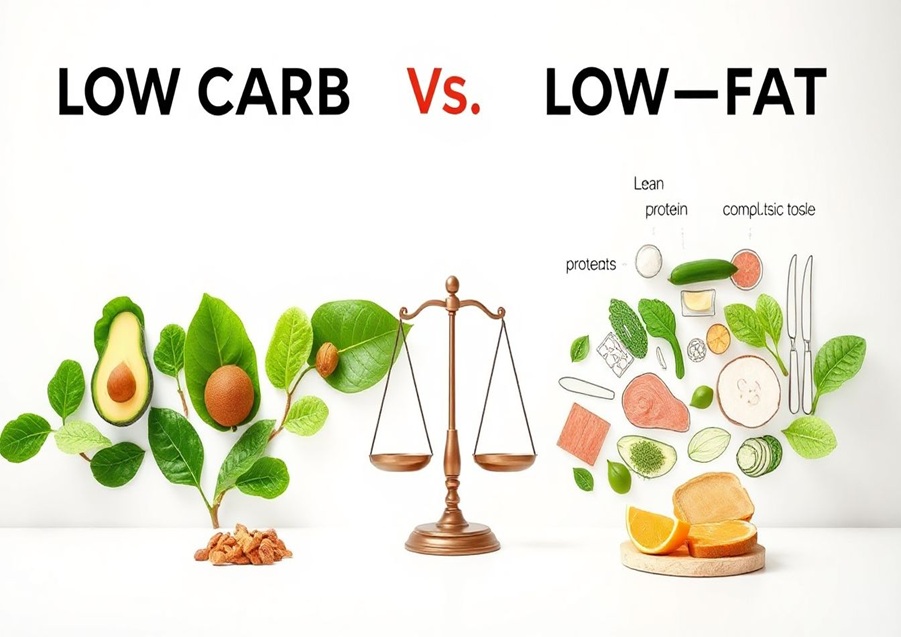Low-Carb vs Low-Fat Diet: Which is Best for Weight Loss?

The weight loss journey often feels overwhelming, with countless diets promising miraculous results. Among the most debated approaches are low-carbohydrate and low-fat diets—two fundamentally different strategies that have dominated nutrition conversations for decades. But which diet truly delivers superior, sustainable weight loss results?
Both dietary approaches work by fundamentally changing how your body processes and uses energy. Low-carb diets restrict sugars and starches, forcing your body to burn fat for fuel. Low-fat diets limit dietary fats to reduce overall calorie intake. Each has robust scientific backing, passionate advocates, and distinct mechanisms of action.
This comprehensive guide examines the science behind both diets, explores their benefits and drawbacks, analyzes what clinical research reveals about effectiveness, and provides actionable guidance to help you choose the right approach for your weight loss goals.
The Science Behind Low-Carb and Low-Fat Diets
Understanding the physiological mechanisms of each diet empowers you to make informed decisions about your nutrition. Both approaches create calorie deficits—the fundamental requirement for weight loss—but through different pathways.
How Low-Carbohydrate Diets Work: Metabolic Fat Burning
Low-carb diets dramatically reduce carbohydrate intake, fundamentally shifting your body’s primary fuel source from glucose to fat. This metabolic transformation offers several weight loss advantages.
The Ketogenic State and Fat Metabolism
When carbohydrate intake drops significantly (typically below 50 grams daily), your body enters ketosis—a metabolic state where the liver converts fat into ketones. These ketone bodies then serve as the primary energy source for your brain and body, making your system highly efficient at burning stored body fat.
The ketogenic diet, the strictest form of low-carb eating, has gained popularity precisely because of this fat-burning metabolic state.
Blood Sugar Stabilization and Insulin Response
Reducing carbohydrate consumption stabilizes blood glucose levels throughout the day. High-carb meals trigger rapid blood sugar spikes, followed by significant insulin release. Since insulin promotes fat storage, keeping levels consistently lower helps your body more readily access and burn stored fat.
Many low-carb dieters report:
- More stable energy levels throughout the day
- Reduced hunger and cravings
- Better blood sugar control (particularly beneficial for diabetics)
- Improved mental clarity and focus
Typical Macronutrient Distribution
A standard low-carb diet features:
- Carbohydrates: Less than 20-50 grams daily (5-10% of calories)
- Fats: 60-75% of total calories from healthy sources
- Protein: 20-30% of calories for muscle preservation
Food choices emphasize meats, fatty fish, eggs, non-starchy vegetables, nuts, seeds, and healthy oils while eliminating grains, sugars, starchy vegetables, and most fruits.
How Low-Fat Diets Work: Calorie Reduction Strategy
Low-fat diets have been mainstream weight loss recommendations for decades, based on the principle that dietary fat contains more calories per gram (9 calories) than carbohydrates or protein (4 calories each).
The Calorie Density Principle
By restricting fat intake, you naturally lower overall calorie consumption—the primary mechanism for weight loss. The focus shifts to lean proteins, fruits, vegetables, and whole grains, which typically provide fewer calories per serving than high-fat alternatives.
This approach aligns with traditional calorie-in, calorie-out models of weight management.
Fiber, Satiety, and Digestive Health
Well-designed low-fat diets emphasize whole grains, legumes, fruits, and vegetables—all excellent sources of dietary fiber. Dietary fiber provides multiple benefits:
- Increases feelings of fullness and satiety
- Slows digestion, preventing rapid blood sugar spikes
- Supports healthy gut microbiome
- Promotes regular bowel movements
- May reduce cholesterol levels
The high fiber content helps prevent overeating while supporting overall digestive health.
Typical Macronutrient Distribution
A standard low-fat diet features:
- Carbohydrates: 50-60% of total calories (primarily from whole sources)
- Protein: 20-30% for muscle maintenance
- Fats: 20-30% of calories (much lower than standard diets)
Food choices include lean meats, low-fat dairy, whole grains, legumes, fruits, and abundant vegetables, while limiting oils, fatty meats, full-fat dairy, and processed high-fat foods.
Benefits and Drawbacks: A Comprehensive Comparison
Both dietary approaches offer distinct advantages and present unique challenges. Understanding these trade-offs helps you determine which aligns better with your preferences, lifestyle, and health goals.
Advantages of Low-Carb Diets
Low-carb eating has gained tremendous popularity due to several compelling benefits, particularly in the initial phases of weight loss.
Rapid Initial Weight Loss
One of the most motivating aspects of low-carb diets is the quick initial weight drop—often 5-10 pounds in the first week or two. While much of this represents water weight loss (as glycogen stores deplete and release bound water), the psychological boost from seeing rapid results helps many people stay committed.
This early success can be incredibly motivating for individuals who have struggled with other diet approaches.
Improved Metabolic Markers
Clinical studies consistently demonstrate that low-carb diets improve several important health markers:
- Triglycerides: Often decrease significantly (30-50%)
- HDL cholesterol: “Good” cholesterol typically increases
- Blood pressure: Many people experience reduced blood pressure
- Blood sugar control: Particularly beneficial for type 2 diabetes management
- Insulin sensitivity: Improved cellular response to insulin
These metabolic improvements suggest broader health benefits beyond just weight loss.
Natural Appetite Suppression
The high protein and fat content in low-carb diets promotes greater satiety compared to carbohydrate-rich meals. Since fats and proteins digest more slowly than carbohydrates, they:
- Keep you feeling full for longer periods
- Reduce hunger between meals
- Minimize cravings and snacking urges
- Make calorie restriction feel less restrictive
This natural appetite control often makes it easier to maintain a calorie deficit without conscious deprivation.
Disadvantages of Low-Carb Diets
Despite the benefits, low-carb eating presents several challenges that can affect adherence and long-term success.
“Keto Flu” and Adaptation Symptoms
Many people beginning very low-carb diets experience an adjustment period called “keto flu“—a collection of temporary side effects including:
- Fatigue and low energy
- Headaches and brain fog
- Dizziness and lightheadedness
- Irritability and mood changes
- Nausea and digestive issues
- Muscle cramps (from electrolyte imbalances)
- Constipation (from reduced fiber intake)
These symptoms typically resolve within 1-2 weeks as your body adapts to fat metabolism, but they can be discouraging for beginners.
Long-Term Sustainability Challenges
Maintaining a strict low-carb diet indefinitely proves difficult for many people due to:
- Social limitations: Difficulty eating at restaurants or social gatherings
- Food variety restrictions: Eliminating entire food groups (grains, most fruits, legumes)
- Cultural incompatibility: Conflicts with traditional eating patterns
- Meal planning complexity: Requires more careful preparation
- Cost considerations: High-quality proteins and fats can be expensive
Research shows that dietary adherence—not diet type—is the strongest predictor of long-term weight loss success.
Potential Nutrient Deficiencies
Without careful planning, low-carb diets may lead to inadequate intake of:
- Fiber: Since whole grains and many fruits are restricted
- Vitamins C and E: Found abundantly in restricted foods
- B vitamins: Particularly from whole grains
- Potassium and magnesium: Important electrolytes
- Phytonutrients: Beneficial plant compounds from diverse produce
Supplementation or strategic food choices become necessary to prevent deficiencies.

Advantages of Low-Fat Diets
Low-fat eating remains popular and offers distinct benefits that appeal to many individuals seeking sustainable weight management.
Cardiovascular Health Benefits
Reducing saturated and trans fat intake aligns with American Heart Association guidelines for heart disease prevention. Low-fat diets typically:
- Lower LDL “bad” cholesterol levels
- Reduce arterial plaque formation
- Decrease cardiovascular disease risk
- Support healthy blood pressure
For individuals with family histories of heart disease, this cardiovascular focus provides peace of mind.
Greater Food Variety and Flexibility
Many people find low-fat diets less restrictive than low-carb alternatives because they allow:
- Whole grains and bread products
- Wide variety of fruits (including higher-sugar options)
- Legumes and beans
- Starchy vegetables like potatoes
- Compatibility with vegetarian and vegan lifestyles
- Easier restaurant and travel eating
This flexibility often translates to better long-term adherence for certain personality types and cultural backgrounds.
High Fiber Intake Benefits
Emphasizing whole plant foods naturally increases dietary fiber, providing numerous health advantages:
- Improved digestive regularity and gut health
- Better blood sugar management
- Reduced cholesterol absorption
- Enhanced satiety and appetite control
- Lower risk of certain cancers
- Support for healthy gut microbiome diversity
The gut health benefits of high-fiber eating extend far beyond weight loss.
Disadvantages of Low-Fat Diets
Low-fat eating isn’t without challenges—some inherent to the approach, others arising from common misinterpretations.
Processed “Low-Fat” Food Trap
One of the biggest pitfalls is relying on commercially processed “low-fat” or “fat-free” products. Food manufacturers often compensate for removed fat by adding:
- Refined sugars and high-fructose corn syrup
- Simple starches and thickeners
- Artificial flavors and additives
- Sodium to enhance taste
These additions can sabotage weight loss efforts and negatively impact metabolic health. Whole food low-fat eating differs dramatically from a diet based on processed low-fat products.
Risk of Low Energy and Nutrient Absorption Issues
Excessively restricting dietary fat can cause:
- Reduced energy levels: Since fats provide concentrated calories
- Hormonal imbalances: Fats are essential for hormone production
- Poor vitamin absorption: Vitamins A, D, E, and K require fat for absorption
- Dry skin and hair: Essential fatty acids support skin health
- Decreased satiety: May lead to overeating carbohydrates
The key is limiting fats to healthy levels (20-30% of calories) rather than eliminating them entirely.
May Not Address Insulin Resistance
For individuals with metabolic syndrome or insulin resistance, simply reducing fat while maintaining high carbohydrate intake may not adequately address the underlying metabolic dysfunction. These individuals might benefit more from carbohydrate reduction and improved carbohydrate quality rather than fat restriction alone.

What Does the Research Say? Evidence-Based Insights
Scientific studies provide crucial evidence about which approach delivers superior results. Numerous clinical trials have directly compared low-carb and low-fat diets, revealing important patterns.
Comparative Studies and Meta-Analyses
Large-scale research reviews synthesize findings from multiple studies to identify overall trends in diet effectiveness.
Short-Term Weight Loss Outcomes (6-12 Months)
Research consistently shows that both diets lead to significant weight loss when followed properly. In the initial 6-12 months:
- Low-carb diets often produce slightly faster initial weight loss (an additional 2-5 pounds on average)
- This advantage likely stems from rapid water weight loss and appetite suppression
- Both approaches typically result in clinically significant weight reduction
- Individual variation is substantial—some people respond much better to one approach
The famous DIETFITS study published in JAMA found no statistically significant difference in 12-month weight loss between healthy low-fat and healthy low-carb diets.
Long-Term Weight Loss (12+ Months)
As timeframes extend beyond one year, the differences between diet types diminish:
- Weight loss differences between approaches largely disappear after 12-24 months
- Both groups typically regain some weight (though often remain below starting weight)
- Adherence becomes the primary predictor of success, not diet type
- Quality of food choices matters more than macronutrient ratios
A comprehensive meta-analysis in the Annals of Internal Medicine concluded that various diet types produce similar long-term weight loss when adherence is comparable.
Metabolic Health Markers
Both diets improve metabolic health, but through different mechanisms:
Low-carb diets excel at:
- Reducing triglycerides (often dramatically)
- Improving HDL cholesterol
- Enhancing blood sugar control
- Increasing insulin sensitivity
Low-fat diets excel at:
- Lowering LDL cholesterol
- Reducing total cholesterol
- Supporting cardiovascular health (when whole-food based)
The specific metabolic improvements depend heavily on diet quality—not just macronutrient ratios.
The Critical Role of Adherence
The most important finding across all diet research: the best diet is the one you can consistently follow.
Why Adherence Matters Most
Studies repeatedly demonstrate that dietary adherence is a stronger predictor of weight loss success than diet type:
- People who stick with their chosen diet lose more weight than those who don’t—regardless of whether it’s low-carb or low-fat
- Drop-out rates are similar across diet types (30-50% within one year)
- Personal preference and lifestyle compatibility determine long-term success
- Forcing yourself into an incompatible diet almost always fails
As nutrition researcher Christopher Gardner states: “The best diet is the one you’ll actually follow.”
Individual Metabolic Variability
People respond to identical diets very differently based on:
- Genetics: Certain gene variants affect carbohydrate and fat metabolism
- Gut microbiome composition: Bacteria in your intestines influence nutrient processing
- Metabolic health status: Insulin resistance changes optimal macronutrient ratios
- Physical activity levels: Exercise affects fuel utilization
- Sleep quality and stress: Hormones influence how you process food
- Age and sex: Metabolic rates and hormonal profiles vary
This individual variability means personalized approaches work better than one-size-fits-all recommendations.
Making Your Choice: Personalized Decision-Making Framework
Selecting between low-carb and low-fat shouldn’t be arbitrary—it requires thoughtful consideration of your unique circumstances, preferences, and health profile.
Key Factors to Evaluate
Personal Food Preferences and Lifestyle
Your enjoyment of food directly impacts adherence. Consider:
Favor low-carb if you:
- Love meat, cheese, eggs, and fatty foods
- Don’t particularly enjoy bread, pasta, or sweets
- Prefer feeling very full after meals
- Cook most of your own meals
- Have flexible social eating situations
Favor low-fat if you:
- Enjoy bread, pasta, rice, and grains
- Love fruit and starchy vegetables
- Prefer lighter, less heavy meals
- Eat out frequently or have limited cooking access
- Follow vegetarian or vegan principles
Your natural food inclinations provide important clues about which approach you’ll sustain long-term.
Current Health Status and Medical Conditions
Certain health conditions may make one approach more beneficial:
Low-carb may be particularly beneficial for:
- Type 2 diabetes or prediabetes
- Insulin resistance or metabolic syndrome
- Polycystic ovary syndrome (PCOS)
- Non-alcoholic fatty liver disease
- Epilepsy (therapeutic ketogenic diet)
Low-fat may be particularly beneficial for:
- High LDL cholesterol or family history of heart disease
- Digestive issues that worsen with high-fat intake
- Gallbladder problems or gallstone history
- Pancreatitis history
- Certain genetic lipid disorders
Always consult healthcare providers before making significant dietary changes, especially if you have existing health conditions or take medications.
Metabolic Type and Genetic Factors
While genetic testing isn’t necessary, observing your body’s responses provides valuable information:
Signs you might do better with lower carbs:
- You feel sluggish and hungry soon after carb-heavy meals
- You experience significant energy crashes mid-afternoon
- You have strong cravings for sweets and starches
- You gain weight easily despite “eating healthy”
Signs you might do better with lower fat:
- High-fat meals make you feel nauseous or overly full
- You feel energized and satisfied after carb-rich meals
- You naturally gravitate toward plant-based eating
- You maintain energy well on grain-based diets
Your body often signals what works best—learn to listen to these cues.
Expert Guidance and Professional Support
Professional input can significantly improve your chances of success while ensuring safety.
Consensus from Major Health Organizations
Most reputable health organizations, including the Academy of Nutrition and Dietetics, recommend:
- Emphasizing whole, minimally processed foods
- Including abundant vegetables and fruits
- Choosing quality protein sources
- Limiting added sugars and refined carbohydrates
- Reducing unhealthy fats (trans fats, excessive saturated fat)
- Maintaining appropriate calorie intake for your goals
These principles apply regardless of whether you choose lower-carb or lower-fat approaches.
When to Seek Professional Guidance
Consider consulting a registered dietitian or physician if you:
- Have existing medical conditions or take medications
- Have a history of disordered eating
- Are pregnant or breastfeeding
- Experience concerning symptoms during dietary changes
- Feel confused about how to implement a diet safely
- Have tried multiple diets without success
Professional guidance prevents nutrient deficiencies, ensures medical safety, and creates personalized plans tailored to your specific needs.
Practical Implementation: Actionable Steps for Success
Regardless of which approach you choose, these evidence-based strategies will maximize your chances of achieving sustainable weight loss.
Starting a Low-Carb Diet: Step-by-Step Guide
If you decide to try low-carb eating, follow these guidelines for a smoother transition:
Week 1-2: Gradual Carb Reduction
- Eliminate sugary beverages, desserts, and obvious sweets
- Replace refined grains (white bread, white pasta) with non-starchy vegetables
- Increase protein intake at each meal
- Add healthy fats like avocado, olive oil, nuts, and seeds
- Stay well-hydrated (aim for 8-10 glasses of water daily)
Week 3-4: Reaching Low-Carb Levels
- Reduce or eliminate grains, legumes, and starchy vegetables
- Focus meals around protein sources: meat, fish, eggs, poultry
- Fill half your plate with non-starchy vegetables
- Include fat sources for satiety: cheese, nuts, oils
- Monitor electrolytes—consider supplementing sodium, potassium, and magnesium
Ongoing Maintenance:
- Track your carbohydrate intake using apps like MyFitnessPal
- Plan meals in advance to avoid last-minute high-carb choices
- Prepare low-carb snacks (hard-boiled eggs, cheese, nuts)
- Find low-carb versions of favorite foods to reduce feelings of deprivation
Starting a Low-Fat Diet: Step-by-Step Guide
If you prefer a low-fat approach, implement these practical strategies:
Week 1-2: Fat Awareness Phase
- Review current eating patterns and identify high-fat foods
- Choose lean protein sources: skinless chicken, turkey, fish, legumes
- Replace cooking oils with non-stick spray or broth-based cooking
- Switch to low-fat or fat-free dairy products
- Read nutrition labels carefully on all packaged foods
Week 3-4: Whole Food Emphasis
- Build meals around whole grains: brown rice, quinoa, oats, whole wheat
- Include abundant fruits and vegetables at every meal
- Use legumes (beans, lentils, chickpeas) as protein sources
- Limit processed “low-fat” products—focus on naturally low-fat whole foods
- Experiment with flavorful herbs and spices instead of butter or oil
Ongoing Maintenance:
- Batch cook grains and legumes for quick meal assembly
- Keep cut vegetables ready for easy side dishes
- Beware hidden fats in restaurant meals and processed foods
- Ensure adequate protein intake to maintain muscle mass
- Include small amounts of healthy fats (nuts, seeds, avocado) for nutrient absorption
Universal Strategies for Both Approaches
These foundational principles support success regardless of your chosen diet:
Portion Control and Mindful Eating
Even healthy foods can hinder weight loss when consumed in excessive quantities:
- Use smaller plates to naturally reduce serving sizes
- Eat slowly and chew thoroughly to recognize fullness cues
- Stop eating when satisfied (not stuffed)
- Avoid eating while distracted by screens or multitasking
- Practice the “80% full” rule common in Blue Zones
Prioritize Whole, Unprocessed Foods
Regardless of macronutrient ratios, whole foods provide superior nutrition:
- Choose foods that resemble their natural state
- Minimize packaged and ultra-processed products
- Cook at home whenever possible for better control
- Read ingredient lists—shorter is generally better
- Shop the perimeter of grocery stores where whole foods are typically located
Combine Diet with Physical Activity
Exercise amplifies weight loss results and provides numerous health benefits:
- Aim for 150+ minutes of moderate activity weekly
- Include both cardio (walking, cycling, swimming) and strength training
- Find activities you genuinely enjoy to ensure consistency
- Remember that exercise supports health even without weight loss
- Consider working with a personal trainer for proper form and motivation
Track Progress and Adjust Accordingly
Monitoring keeps you accountable and provides valuable feedback:
- Weigh yourself weekly (not daily—normal fluctuations can be discouraging)
- Take body measurements monthly
- Pay attention to non-scale victories: energy levels, clothing fit, mood, sleep quality
- Keep a food journal to identify patterns and problem areas
- Be willing to modify your approach if results plateau or you feel unwell
Conclusion: The Best Diet is the One You’ll Actually Follow
The decades-long debate between low-carb and low-fat diets reveals a crucial truth: there is no universally superior approach for weight loss. Both strategies are backed by solid science, both can produce significant results, and both improve health markers when implemented properly with whole foods.
The research is clear—individual adherence determines success far more than diet type. The most effective diet is one that:
- Aligns with your food preferences and lifestyle
- Fits your cultural and social context
- Addresses your specific health needs
- Feels sustainable for the long term
- Doesn’t cause excessive stress or deprivation
Sustainable weight loss emerges from consistent healthy behaviors: eating predominantly whole foods, controlling portion sizes, staying physically active, managing stress, and getting adequate sleep. Quick fixes and extreme restrictions rarely lead to lasting change.
Approach your diet choice with flexibility and self-compassion. Experiment with different approaches, pay attention to how your body responds, and be willing to adjust your strategy based on results and feelings. Consider consulting healthcare professionals who can provide personalized guidance based on your unique health profile.
Remember that the journey toward better health transcends any single dietary label—it’s about creating sustainable habits that support your overall well-being for life.

What’s your experience with low-carb or low-fat diets? Which approach has worked best for you?

